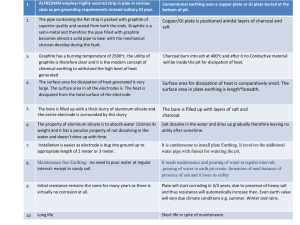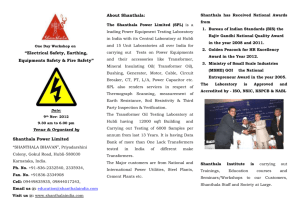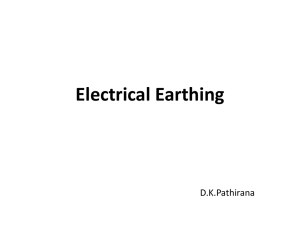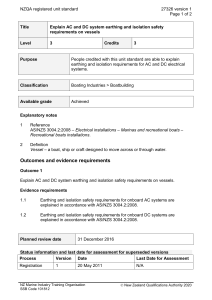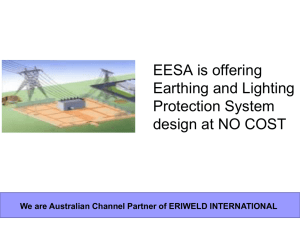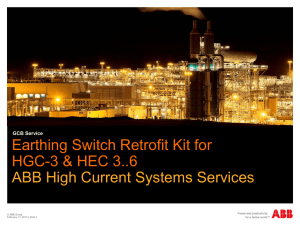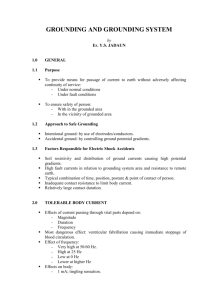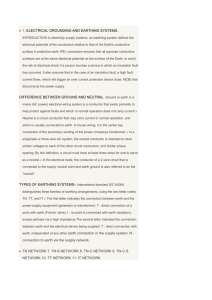CHAPTER -1 INTRODUCTION INTRODUCTION Electricity is
advertisement
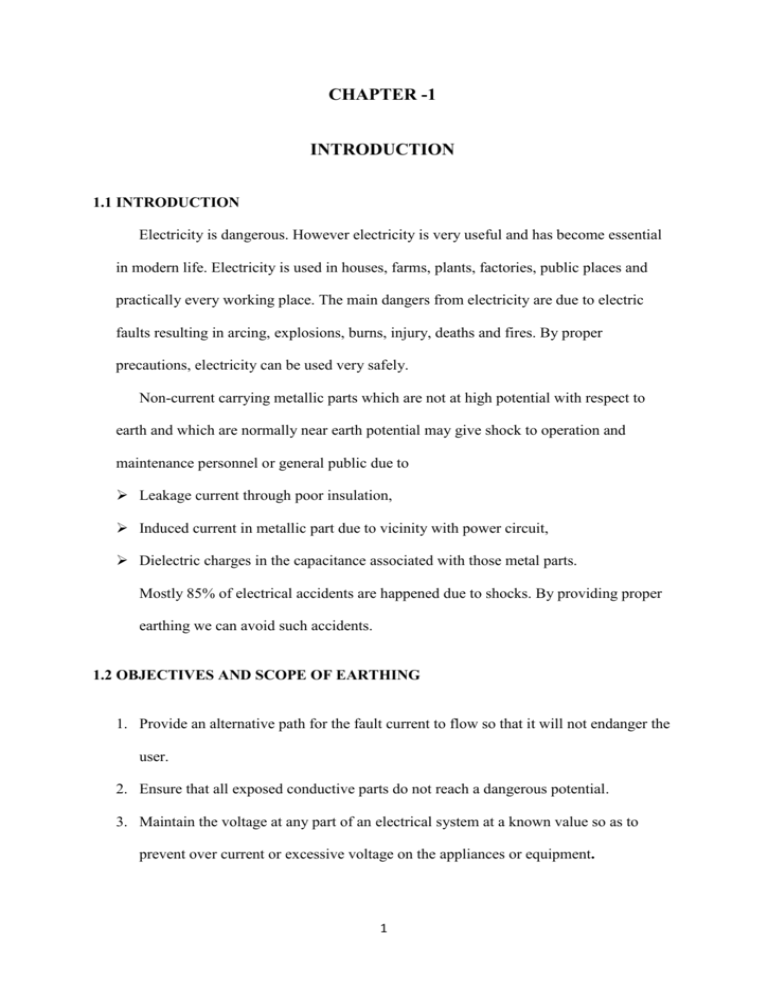
CHAPTER -1 INTRODUCTION 1.1 INTRODUCTION Electricity is dangerous. However electricity is very useful and has become essential in modern life. Electricity is used in houses, farms, plants, factories, public places and practically every working place. The main dangers from electricity are due to electric faults resulting in arcing, explosions, burns, injury, deaths and fires. By proper precautions, electricity can be used very safely. Non-current carrying metallic parts which are not at high potential with respect to earth and which are normally near earth potential may give shock to operation and maintenance personnel or general public due to Leakage current through poor insulation, Induced current in metallic part due to vicinity with power circuit, Dielectric charges in the capacitance associated with those metal parts. Mostly 85% of electrical accidents are happened due to shocks. By providing proper earthing we can avoid such accidents. 1.2 OBJECTIVES AND SCOPE OF EARTHING 1. Provide an alternative path for the fault current to flow so that it will not endanger the user. 2. Ensure that all exposed conductive parts do not reach a dangerous potential. 3. Maintain the voltage at any part of an electrical system at a known value so as to prevent over current or excessive voltage on the appliances or equipment. 1 1.3 NEED FOR GOOD EARTHING To save human life from danger of electrical shock or death by blowing a fuse. To protect buildings, machinery & appliances under fault conditions. To provide safe path to dissipate lightning and short circuit currents. To provide stable platform for operation of sensitive electronic equipments i.e. To maintain the voltage at any part of an electrical system at a known value so as to prevent over current or excessive voltage on the appliances or equipment . To provide protection against static electricity from friction. 1.4 CHAPTER ORGANISATION 1. The second chapter deals with the earthing standards and types of earthing. 2. The third chapter details deals with the major components of earthing. 3. The fourth chapter deals with the layout of earthing. 4. Discussion on maintenance of earthing is given in chapter five. 5. The sixth chapter deals with the conclusion. 2 CHAPTER -2 EARTHING 2.1 EARTHING AND GROUNDING It is a universal practice to ground (earth) every non-current carrying metallic part associated with electrical equipment, plant, installation to ensure safety. Grounding is same as earthing. The term Grounding (or ground) is used in USA, Canada, Japan and is defined in IEEE Standard Dictionary as ‘Conducting connection to the earth’. The term Earthing (or earth) is used in India, UK, Europe and IEC standards. Earth is a good conductor. It can absorb infinite charge without rise in voltage. Hence earthed point is always at very low potential. 2.2 EARTHING STANDARDS 2.2.1 DOMESTIC, COMMERCIAL AND INDUSTRIAL PREMISES (i.e. installations up to 1,000 V ac and 1,500 V dc - between phases, with some minor exceptions). 2.2.1.1 Existing BS 7671 1992, Amendment 1, 1994. Requirements for Electrical Installations. (This is also known as the IEE Wiring Regulations, 16th Edition). Applies to all aspects of new 3 electrical installations and requires that older installations are re-appraised when they are extended. 2.2.2 HIGH AND MEDIUM VOLTAGE ELECTRICITY SUBSTATIONS 2.2.2.1 BS 7354:1990 Code of Practice for Design of high-voltage open-terminal stations, Section 7: Earthing This covers substation construction and design considerations and includes some formulae. Some safety limits are introduced. 2.2.2.2 BS 7430:1991 Code of Practice for Earthing It covers construction and measurement and includes resistance formulae, ratings, and material selection. Guidance is given for the earthing of many specific applications including protection of solid state devices against static electricity. It applies to all land based systems except medical equipment. 2.2.2.3 EA Technical Specification 41-24:1992 (Issued 1994) This gives the guidelines for the design, testing and maintenance of main earthing systems in substations. This document is intended to be used in conjunction with BS 7430, and ER S.34. It supersedes ER S5/1 and covers the design of substation earthing, including some formulae. Guidelines are given for the construction, maintenance and measurement of the earthing system. 2.2.2.4 EA Engineering Recommendation S.34:1986 4 This is a guide for assessing the rise of earth potential at substation sites. The core technical reference document for the electricity supply industry in Britain. It includes resistance formulae, current distribution formulae and monograms. 2.2.2.5 prEN 50179 Power Installations Exceeding 1 kV ac or 1.5 kV dc This is a new European standard, presently in near final draft form and currently called CLC TC/112. This is an attempt to standardise earthing practices in Europe and is likely to come into effect in 1996 as a framework type document. It is likely to establish general rules but not include detailed technical application guidance. It will be necessary for all the present British Standards and Codes of Practice to be reviewed and amended once this comes into force. In turn, this will require a more detailed design of the earthing systems, probably involving additional electrodes. Minimum cross sectional areas for earth conductors are 16 mm² for copper, 35mm² for aluminium and 50 mm² for steel. 2.2.3 OTHER RELEVANT STANDARDS 2.2.3.1 DIN VDE 0141: 1989 Technical Help to Exporters Translation This is for earthing systems for power installations with rated voltages above 1 kV. General principles are introduced and some resistance formulae given. The basis of the design of the earthing system is a series of tables giving the relevant criteria for different systems. Construction, inspection and maintenance are also covered. 2.2.3.2 ANSI/IEEE Std. 80: 1986 5 This is an IEEE guide for safety in ac substation grounding. It is a comprehensive USA standard which covers design and technical aspects. It covers soil modelling, fault current distribution, worked examples and special considerations, e.g. Gas insulated switchgear (GIS). This standard is generally considered to be stringent in its approach. 2.2.3.3 CCITT Directives These mainly involve electromagnetic interference in telecommunication cables, arising from power and electrified rail systems. All components used in the manufacture of the pillars shall confirm to the relevant Indian standard specification and especially to the followings: Table 2.1 Standard codes for earthing 1 IS: 3043/1987 Code of practice for Earthing 2 IS 1239 part Steel Tubes, Tubulars and Other Wrought Steel Fittings - 1/2004 Specification - Part 1 : Steel Tubes IS 1239 part Mild steel tubes, tubulars and other wrought steel 3 fittings, Part 2 Mild steel tubulars and other wrought 2/1992 steel pipe fittings 4 IEEE-80 IEEE Guide for Safety in AC Sub Station Grounding 5 IEEE-837 Standard for Qualifying permanent connection in Sub Station Grounding 2.3 IEC TERMINOLOGIES OF EARTHING SYSTEMS 6 International standard IEC 60364 distinguishes three families of earthing arrangements, using the two-letter codes TN, TT, and IT. The first letter indicates the connection between earth and the power-supply equipment (generator or transformer): T Direct connection of a point with earth (Latin: terra); I No point is connected with earth (isolation), except perhaps via a high impedance. The second letter indicates the connection between earth and the electrical device being supplied: T Direct connection of a point with earth N Direct connection to neutral at the origin of installation, which is connected to the earth. 2.3.1 TN NETWORKS In a TN earthing system, one of the points in the generator or transformer is connected with earth, usually the star point in a three-phase system. The body of the electrical device is connected with earth via this earth connection at the transformer. 7 Fig.2.1 TN earthing system The conductor that connects the exposed metallic parts of the consumer's electrical installation is called protective earth. The conductor that connects to the star point in a three-phase system, or that carries the return current in a single-phase system, is called neutral (N). Three variants of TN systems are distinguished: TN−S PE and N are separate conductors that are connected together only near the power source. This arrangement is the current standard for most residential and industrial electric systems in North America and Europe. TN−C A combined PEN conductor fulfills the functions of both a PE and an N conductor. Rarely used. TN−C−S 8 Part of the system uses a combined PEN conductor, which is at some point split up into separate PE and N lines. The combined PEN conductor typically occurs between the substation and the entry point into the building, and separated in the service head. In the UK, this system is also known as protective multiple earthing (PME), because of the practice of connecting the combined neutral-and-earth conductor to real earth at many locations, to reduce the risk of broken neutrals - with a similar system in Australia being designated as multiple earthed neutral (MEN). TN-S: separate protective TN-C: combined PE and N TN-C-S earthing system: earth (PE) and neutral (N) conductor all the way from the combined PEN conductor conductors from transformer transformer to the consuming from transformer to building to consuming device, which device. distribution point, but separate are not connected together at PE and N conductors in fixed any point after the building indoor wiring and flexible distribution point. power cords. Fig.2.2 TN-S, TN-C, TN-C-S earthing system 9 It is possible to have both TN-S and TN-C-S supplies from the same transformer. For example, the sheaths on some underground cables corrode and stop providing good earth connections, and so homes where "bad earths" are found get converted to TN-C-S. 2.3.2 TT NETWORK In a TT earthing system, the protective earth connection of the consumer is provided by a local connection to earth, independent of any earth connection at the generator. The big advantage of the TT earthing system is that it is clear of high and low frequency noises that come through the neutral wire from connected equipment. TT has always been preferable for special applications like telecommunication sites that benefit from the interference-free earthing. Also, TT does not have the risk of a broken neutral. Fig.2.3 TT earthing system 2.3.3 IT NETWORK 10 In an IT network, the distribution system has no connection to earth at all, or it has only a high impedance connection. In such systems, an insulation monitoring device is used to monitor the impedance. Fig.2.4 IT earthing system 11 TABLE 2.2 Comparison of Earthing systems TT IT TN-S TN-C TN-C-S High Highest Low Low Low RCD preferred? Yes No Yes No No Need earth electrode Yes Yes No No No Low Low Highest Least High No No No Highest High Safe Less Safe Safest Least Safe Earth fault loop impedance at site? PE conductor cost Risk of broken neutral Safety Safe Electromagnetic Least Least Low High Low High loop Double fault, Broken Broken Broken impedance overvoltage PE neutral neutral Safe and Continuity of Safest Cost Safety reliable operation, cost interference Safety risks Advantages 12 and cost 2.4 CLASSIFICATION OF EARTHING Earthing can be classified into the following categories based on the purpose for which the part of the equipment connected to the general mass of earth. System Earthing Equipment Earthing Reference Earthing Discharge Earthing Out of those systems earthing, Equipment earthing are most commonly made in industries. Based on the usage earthing can be classified into Conventional earthing. Maintenance free earthing. 2.4.1 SYSTEM EARTHING Earthing associated with current carrying parts of the equipment is called system earthing. The system security, reliability, performance, voltage stabilization, all relied only on the system earthing. Eg. Earthing neutral of transformer, Surge arrester earthing. System earthing is further classified into Ungrounded Systems Solid Grounding Resistance grounding Resonant grounding 13 2.4.1.1 Ungrounded Systems: Ungrounded system is an electrical power system that is operating with no intentional ground connection to the system conductors are generally described as ungrounded. In reality, these systems are grounded through the system capacitance to ground. In most systems, this is extremely high impedance, and resulting system relationships to ground-to-ground are weak and easily distorted. Two principal advantages are attributed to ungrounded systems. Operational: The first ground fault on a system causes only a small ground current to flow, so the system may be operated with ground fault present, improving system continuity. Economic: No expenditures are required for grounding equipment or grounded system conductors. Numerous advantages are attributed to grounded systems, including greater safety freedom from excessive system over-voltages that can occur on ungrounded systems during arcing resonant or near-resonant ground fault easier detection and location of ground faults when they do occur. 2.4.1.2 Solid Grounding: 14 Fig.2.5 Solid Grounding A system is considered to be solidly grounded when its neutral is connected directly to a station ground or earth with no intentional impedance in that connection. Ground fault currents on solidly grounded systems are about equal to three-phase fault currents. Low-voltage systems (600 Volts and below) are usually solidly grounded (when grounded) because most low-voltage protective devices (circuit breakers and fuses) are phase-type devices, and require high currents to operate. New static devices do permit ground detection at much lower current values than phase trip devices. Fig.2.6 Solidly Grounded System Some restrictions of Solidly grounding are 15 1. Grounding of solidly grounded neutral systems shall be accomplished in a manner illustrated by fig.3.2 if the system neutral is available at the service entrance equipment. 2. The neutral grounding conductor shall be permitted to be a bare conductor if properly isolated from phase conductors and protected from physical damage. 3. Equipment grounding circuit conductors shall be permitted to be bare and shall be connected to the ground bus and grounding electrode conductor at the service entrance equipment. (See Diagram 2740.) 4. Multiple grounding of the equipment grounding conductor is permitted. 5. The use of multiple neutral grounds on exterior wiring systems is permitted. 2.4.1.3 Resistance grounding: 2.4.1.3.1 High resistance grounding Condition of High resistance grounding are 1. The conditions of maintenance and supervision assure that only qualify person will service the installation. 2. Continuity of power is required. 3. Ground detectors are installed on the system 4. Line-to-neutral loads are not served. The resistor of a high-resistance scheme is sized according to the following steps: 1. Measure the charging current or estimate the capacitive reactance of the system. 2. Select the size of the grounding resistor such that it is equal to or slightly less than one third of the system. ie. 16 R ≤ Xc/3 or R ≤ VLG/3ICO This will provide a low fault current to minimize damage, yet it will limit transient over voltages to less than 2.5 times the normal crest value to ground. 2.4.1.4 Low resistance grounding (Neutral resistor ground): This method is used when generators directly connected to the system without a stepup transformer. It permits a higher level of fault current, which is generally several hundred amperes to about 150% of rated machine current. It permits sufficient fault current to operate the differential relays for all machine faults except those near the machine neutral. This resistor should also meet dielectric requirements of full phase-to-ground voltages or better. 2.4.1.5 Resonant grounding: This method can be used for the unit-connected generators. The main purpose of this method is to minimize phase-to-ground fault current. The power dissipated in the effective resistance should be equal to or greater than the three-phase zero-sequence capacitive reactance of the generator bus. X0 (reactance) ≤ Xc0 ( zero sequence capacitance) / 3 This method of grounding is used primarily on systems above 15kv, consisting largely of overhead transmission or distribution lines. 2.4.2 EQUIPMENT EARTHING Earthing associated with non-current carrying parts of electrical equipment are called as Equipment Earthing. Safety of operator, consumer safety of their property are mainly based on equipment earthing. 17 Eg. Body of the Transformer, Body of Motor 2.4.3 CONVENTIONAL EARTHING The Conventional system of Earthing calls for digging of a large pit into which a GI pipe or a copper plate is positioned amidst layers of charcoal and salt. It is cumbersome to install only one or two pits in a day. The Conventional system of GI pipe Earthing or copper plate Earthing requires maintenance and pouring of water at regular interval. 2.4.4 MAINTENANCE FREE EARTHING It is a new type of earthing system which is ready made, standardized and scientifically developed. 2.4.4.1 Advantages of free earthing 1. Maintenance Free: No need to pour water at regular interval- except in sandy soil. 2. Consistency: Maintain stable and consistent earth resistance around the year. 3. More Surface Area: The conductive compound creates a conductive zone, which provides the increased surface area for peak current dissipation. And also get stable reference point. 4. Low earth resistance. Highly conductive. Carries high peak current repeatedly. 5. No corrosion. Eco Friendly. 6. Long Life. 7. Easy Installation. 18 CHAPTER -3 EARTHING COMPONENTS 3.1 COMPONENTS OF EARTHING SYSTEM Earthing system in an installation is normally comprised of these components: 1. Earth wells and accessories. 2. Earthing grid conductors. 3. Marshalling earth buses (earthing distribution buses). 4. Earthing wires and cables. 5. Lightning arresters and accessories. 3.1.1 EARTH WELLS AND ACCESSORIES Earth wells for an specific building or installation are actually the location, where the pure zero potential is provided and practically act as drain pits for any rush current which accidentally appears in the earthing system grid in the event of an earth fault (connection of electrical live parts to the earthing system). Depending on the soil conductivity of the location in which the earth wells are installed and also depending on the required technical specifications of the earthing system, different types of components can be used to set up an earth well. Followings are the prime components and accessories of an earth well. 19 1. Earth Electrode 2. Carbon bedding mixed with salt 3. Concrete earth pit 4. Concrete slab cover 3.1.1.1 Earth Electrodes The earth electrode is the component of the earthing system which is in direct contact with the ground and thus provides a means of releasing or collecting any earth leakage currents. In earthed systems it will normally be required to carry quite a large fault current for a short period of time and so will need to have a cross-sectional area large enough to be able to carry this safely. Electrodes must have adequate mechanical and electrical properties to continue to meet the demands on them over a relatively long period of time, during which actual testing or inspection is difficult. The electrode can take a number of forms. These include vertical rods, plates and horizontal conductors, the most common of which are described below. 3.1.1.1.1 Rods These are the most common form of electrode, because they are relatively cheap to install and can be used to reach into deeper, low resistivity soil with only limited excavation and backfilling. They are available in a range of lengths, diameters and materials complying with the Electricity Association Technical Specification 43-94. 20 The rod is either of pure copper or copper plated steel. The plated type is normally used when mechanical driving is necessary, since the steel used has high tensile strength. The copper plating should be of high purity copper and electrolytically applied. Rods are readily available in diameters of 15 mm to 20 mm diameter (solid copper) and 9.5 mm to 20 mm diameter (Copper Bond). Lengths are 1.2 to 3 metres for individual rods. The resistance of a pipe or rod electrode is given by: 𝑅= 100 𝜌 2𝜋𝑙 log 𝑒 4𝑙 ohms 𝑑 l = length of rod or pipe (in cm ), d = diameter of rod or pipe in cm, and ρ = resistivity of the soil ( in ohm.m )( assumed uniform ). 21 ...(3.1) Fig. 3.1 Typical arrangement of Pipe Electrode All dimensions in millimetres. 22 After laying the earth from the earth bus to the electrode through the PVC conduits at the pit entry conduits should be sealed with bitumin compound. 3.1.1.1.2 Plates There are several types of plate used for earthing purposes, but the only type which is generally considered as an electrode would be solid and of substantial size. Lattice type plates, as illustrated in Figure 4-1 are used for potential grading and would not be expected topass significant amounts of fault current. They are normally made of copper or steel mesh. Fig.3.2 Earth Plates (courtesy A N Wallis and Co) Plate electrodes are of copper or ribbed cast iron. The cast iron plates normally are a minimum of 12 mm thick and either 915 mm or 1,220 mm square. Copper plates are typically 600 mm to 900 mm square and between 1.6 mm and 3 mm thick. Where multiple plates are used, they must be some distance apart to prevent any interaction. Normally this is a minimum of 2 m, possibly extending to 9 m. The approximate resistance to earth of a plate can be calculated from: 23 𝑅= 𝜌 𝐴 √𝜋/𝐴 ohms where ρ = resistivity of the soil ( assumed uniform) ( in ohm.m) A = area of both sides of the plate (in m* ). Fig.3.3 Typical arrangement of Plate Electrode All dimensions in millimetres. 24 ...(3.2) 3.1.1.1.3 Horizontal electrodes These are made from high conductivity copper strip or stranded conductor. It can be more difficult to connect (for example to vertical earth rods), so may involve a slightly higher installation cost. 3.1.1.2 Carbon Bedding Depending on the technical design specification of the earthing system and primarily for soil conductivity reasons of the area where the earth wells are to be installed, the earth rods are embedded in carbon bedding. To install the carbon bedded earth wells, preexcavation of the ground, to sufficient size and dimension, would be carried out to provide room for the carbon bedding and the earthing components (rods, plates, etc.). 3.1.1.3 Concrete Earth Pit To provide access to the earth rod and its corresponding connection to the earthing grid at the top section of the rod, a small pit-like space is fabricated over the earth well, which is referred to as “earth pit”. Earth pit’s side walls are constructed of concrete material to appropriately isolate the earth rod’s top connection from the surrounding soil. 3.1.2 EARTHING GRID CONDUCTORS All electrical earth wells in a specific residential, commercial and industrial installation should essentially be interconnected to plant earthing systems form the main earthing grid. 3.1.2.1 Different Types of Grid Conductors Interconnecting conductor used for the grid are in the following forms: 25 1. Bare copper strip conductor 2. Single core bare stranded copper cable 3. Single core stranded copper cable with PVC sheath 4. Copper strip conductor with PVC covering 3.1.2.2 Earthing Grid Conductors Dimension Depending on the design specification of the earthing system, the size of the grid conductors, would be different as followings: For bare or PVC-covered cables, the cross section area of the cable could be either 35mm2, or 70mm2, or 95mm2 depending on the design specification. For bare or PVC-covered copper strips, the cross section dimension of the strip is normally 25 × 3mm. 3.1.3 MARSHALING EARTH BUS To provide easy access to the earthing grid, particularly to make proper and convenient connections of the equipment to the grid, several common connection points in the form of a flat bar of copper material are established and erected through out the grid and referred to as “earthing marshalling points” or “earthing marshalling bus”, or simply as “earth bus”. The main incoming earthing cable connected to the earth bus is branched off from the main earthing grid. The outgoing earthing cables, connected to the earth bus in one end, shall be connected to the corresponding equipment on the other end. 26 All the connections of the main incoming and outgoing earth cables shall be made to the earth bus by means of appropriate cable lugs the compression type and zink coating, using bolts, nuts, flat washers and spring washers for well-tight connections. 3.1.4 EARTHING WIRES (CABLES) Connections between the marshalling earth buses and the equipments are carried out by means of single wires or cables of appropriate size, which are referred to as “earthing wire”, or “earthing link”. The connection between the earthing buses and the earthing grid is also made by means of earthing cables. Earthing wires and cables are used either bare or PVC-covered (preferably bare) and are normally single core of the different cross section area, depending on the design specification. 3.1.5 LIGHTNING ARRESTOR AND ACCESSORIES To protect the installation against the damages which could happen in the event of a lightning strike, special equipment of different installation set-up are used. The prime element of these electrical safety equipment is the lightning arresters which are installed on the highest point of an installation which are most liable to be struck by the lightning. Lightning arresters are actually part of the earthing system of an installation and are, therefore, appropriately connected to the main earthing grid by means of separate purpose made earth wells. 27 3.2 EARTH RESISTANCE Effectiveness of the earthing connection made by embedding a metal plate in earth is quantified as "Earth Resistance". This earth resistance is measured in ohms. Earth resistance consists of following components Resistance of metal electrode Contact resistance between electrode and soil Resistance of soil away from electrode surface. 3.3 EARTH RESISTANCE TEST This test shows the resistance offered by the earthing rods with the connection leads. Various testing instruments are available for earthing resistance tests. The earthing resistance should be less than 5 Ohm. 3.4 MEASUREMENT OF EARTH RESISTIVITY 3.4.1 RESISTIVITY OF THE SOIL The resistivity of the earth varies within extremely wide limits, between 1 and 10 000 ohm metres. The resistivity of the soil at many station sites has been found to be nonuniform. Variation of the resistivity of the soil with depth is more predominant as compared to the variation with horizontal distances. Wide variation of resistivity with depth is due to stratification of earth layers. In some sites, the resistivity variation may be gradual, where stratification is not abrupt. Highly refined techniques for the determination of resistivity of homogeneous soil are available. To design the most economical and technically sound grounding system for large stations, it is necessary to obtain accurate data on the soil 28 resistivity and on its variation at the station site. Resistivity measurements at the site will reveal whether the soil is homogeneous or non-uniform. In case the soil is found uniform, conventional methods are applicable for the computation of earth resistivity. When the soil is found non-uniform, either a gradual variation or a two-layer model may be adopted for the computation of earth resistivity. The resistivity of earth varies over a wide range depending on its moisture content. It is, therefore, advisable to conduct earth resistivity tests during the dry season in order to get conservative results. 3.4.2 TEST LOCATIONS In the evaluation of earth resistivity for substations and generating stations, at least eight test directions shall be chosen from the centre of the station to cover the whole site. This number shall be increased for very large station sites of it, the test results obtained at various locations show a significant difference, indicating variations in soil formation. In case of transmission lines, the measurements shall be taken along the direction of the line throughout the length approximately once in every 4 kilometres. 3.4.3 PRINCIPLE OF TESTS Wenner's four electrode method is recommended for these types of field investigations. In this method, four electrodes are driven into the earth along a straight line at equal intervals. A current is passed through the two outer electrodes and the earth as shown in Fig. 3.6 and the voltage difference V, observed between the two inner electrodes. The current I flowing into the earth produces an electric field proportional to its density and to the resistivity of the soil. The voltage V measured between the inner electrodes is, therefore, 29 proportional to the field. Consequently, the resistivity will be proportional to the ratio of the voltage to current. The following equation holds for: 𝜌= 4𝑠𝜋𝑉 𝐼 1+ ...(3.3) 2𝑠 2𝑠 − √𝑠2 +4𝑒2 √4 𝑠2 +4 𝑒2 where ρ - Resistivity of soil in ohm-metre, s - Distance between two successive electrodes in metres, V - Voltage difference between the two inner electrodes in volts, I - Current flowing through the two outer electrodes in amperes, e - Depth of burial of electrode in metres. If the depth of burial of the electrodes in the ground d is negligible compared to the spacing between the electrodes, then 𝜌= 2𝜋𝑠𝑉 ...(3.4) 𝐼 Earth testers normally used for these tests comprise the current source and meter in a single instrument and directly read the resistance. The most frequently used earth tester is the four-terminal megger shown in Fig. 33. When using such a megger, the resistivity may be evaluated from the modified equation as given below: ...(3.5) 𝜌 = 2𝜋𝑠𝑅 30 where ρ - resistivity of soil in ohm-metres, s - distance between successive electrodes in metres, and R = megger reading in ohms. Fig. 3.4 Connections for a four terminal megger 3.4.4 TEST PROCEDURE At the selected test site, in the chosen direction, four electrodes are driven into the earth along a straight line at equal intervals, s. The depth of the electrodes in the ground shall be of the order of 10 to 15 cm. The megger is placed on a steady and approximately level base, the link between terminals PI and Gl opened and the four electrodes connected to the instrument terminals as shown in Fig. 33. An appropriate range on the instrument is thus selected to obtain clear readings avoiding the two ends of the scale as far as possible. The readings are taken while turning the crank at about 135 rev/min. 31 3.4.4.1 Correction for Potential Electrode Resistance In cases where the resistance of the potential electrodes (the two inner electrodes) is comparatively high, a correction of the test results would be necessary depending on its value. For this purpose, the instrument is connected to the electrodes as shown in Fig. 34. The readings are taken as before. The correction is then effected as follows. Let the readings of the megger be Rp with the connections as shown in Fig. 3.7 and the electrode spacing in metres. If the uncorrected value of soil resistivity is 𝜌′ and the resistance of the voltage circuit of the instrument used to obtain R ( as indicated inside the scale cover of the meter ) is Rv, the corrected value of the earth resistivity would be: 𝜌 = 𝜌′ (𝑅𝑣 + 𝑅𝑝)/𝑅𝑣 ...(3.6) Fig.3.5 Test connection to measure the sum of the potential electrode resistances 32 3.5 SOIL RESISTIVITY The resistance to earth of a given electrode depends upon the electrical resistivity of the soil in which it is installed. This factor is, therefore, important in deciding which of many protective systems to adopt. The type of soil largely determines its resistivity and examples are given in Table 3.1. Earth conductivity is, however, essentially electrolytic in nature and is affected, by the moisture content of the soil and by the chemical composition and concentration of salts dissolved in the contained water. The effective resistivity depends not only on the surface layers but also on the underlying geological formation. It should also be noted that soil temperature has some effect, but is only important near and below freezing point, necessitating the installation of earth electrodes at depths to which frost will not penetrate. It is, therefore, recommended that the first metre of any earth electrode should not be regarded as being effective under frost conditions. While the fundamental nature and properties of a soil in a given area cannot be changed, use can be made of purely local conditions in choosing suitable electrode sites and methods of preparing the site selected to secure the optimum resistivity. 33 Table 3.1 Soil resistivity of different types of soils S.NO TYPES OF SOIL RESISTIVITY IN OHM METERS 1 Marsheel 1-5 2 Clay 3-150 3 Clay sand and gravel moisture 10-1250 4 Chalk 60-500 5 Sand 90-1000 6 Sand and gravel mixture 500-5000 7 Slate 100-500 8 Crystalline rock 500-10,000 34 CHAPTER -4 LAYOUT OF EARTHING 4.1 EARTHING IN SUBSTATION In general, earthing installations will be required at power stations and substations for: The neutral points of each separate electricity system which has to be earthed at the power station or substation; Apparatus fremework or cladding or other non-current carrying metalwork associated with each system, for example, transformer tanks, power cable sheaths; Extraneous metalwork not associated with the powersystems, for example boundary fences, sheaths of control or communication cables. 35 Fig.4.1 A typical grid for an outdoor substation (66kV and above) 36 A typical earthing arrangement for an outdoor switchyard is shown in Fig. 22. A typical earthing arrangement for connecting the reinforcement of foundations of substation building and switchyard RCG masts is shown in Fig. 23. Fig.4.2 Earthing of foundation reinforcement (concrete encased earthing electrode) NOTE 1. Top ring should be half the size of main vertical reinforcement rod. 2. Two extreme columns should be earthed like this in each substation. 37 3. This is applicable to RCG masts and equipment supports in OD switchyard. 4. Inserts other than earthing pads may or may not be welded to reinforcement. The perimeter fence may need to be earthed separately from the main station earth electrode system. The tertiary winding of a power transformer should be connected to the transformer tank by a connection of sufficient cross-sectional area to carry the primary short-circuit current. In the case of pole mounted transformers on overhead line systems, difficulties may arise in areas of high soil resistivity. Here, if the pole carries also isolating switchgear with low level operating handle, up to three separately earthed electrode systems may be required. That for the neutral of the low voltage system is usually provided not nearer than one pole span away on the low voltage line. That for the high voltage metalwork (transformer tank, switch framework, support metal work), consists of one earth electrode at or near the pole. Resistances of 5 to 50ῼ are sometimes the minimum economically possible. In addition, an earth mat should be provided, near the ground surface, in the position taken up by a person operating the switch handle; this mat should be connected to the switch handle. The mat should be electrically separated from the main electrode; this is considered to be achieved by spacing the ¼ nearest element of that electrode at least 1 m from the periphery of the mat and by placing the two earthing-wires on opposite sides of the pole. The tops of the main electrodes should be at least 225 mm and preferably 750 mm below the ground, and the earthing wire to the main electrode of outdoor type rubber or plastics-insulated cable up to a point 2 m above ground level. This cable, between the bottom of the pole and the electrode should be laid in a 50mm diameter earthenware duct filled solid with bitumen. 38 CHAPTER -5 MAINTENANCE OF EARTHING SYSTEMS 5.1 INTRODUCTION Where an electricity supplier provides an earth terminal at premises, maintenance of the earthing and bonding system is confined to maintenance of the conductors and connections which form part of that system. At special locations, e.g. on an IT or TT system, the occupant/owner is required to provide an independent earth electrode, and any maintenance procedure must include this electrode. For electricity suppliers, or other owners of distribution networks, maintenance of their earthing and bonding systems involves work on both the bonding conductors above ground and the buried electrode. For the electrode, testing from above ground has been the accepted method of verifying its condition. Corrosion can take place on some electrode components or joints. A test of the earthing system impedance will not necessarily detect this corrosion and is not, on its own, sufficient to indicate that the earthing system is adequate. For electrode systems associated with the higher voltage networks, selected excavation and inspection of electrode systems is now recommended. 5.2 PHILOSOPHY OF MAINTENANCE Maintenance of earthing systems normally forms part of the maintenance of the overall electrical system. The quality and frequency of the maintenance should be sufficient to prevent danger, so far as is reasonably practicable. Recommendations on the type of maintenance required and the frequency for various types of installation can be found in the following documents: 39 For domestic and commercial premises, in BS 7671. For factories, the HSE. has issued a “Memorandum of Guidance on the Electricity at Work Regulations 1989”. In Appendix 2, a list is given of the various documents which should be referred to for a variety of specialist applications. The Electricity Supply Regulations, 1988 as amended, impose a duty on Electricity Suppliers to inspect their installations and works. The frequency of maintenance and the recommended practice at any installation depend upon the type and size of the installation, its function and its voltage level. For example, it is recommended that domestic premises are tested every five years and industrial premises every three. Places with public access require more frequent inspection and those requiring an annual inspection include petrol stations, caravan sites, theatres, cinemas and launderettes. All forms of installation should be subject to two types of maintenance. Inspection, at frequent intervals, of those components which are, or can readily be made, accessible. Examination which includes a more thorough inspection than that possible by inspection, possibly including testing. 5.3 INSPECTION Inspection of the earthing system at an installation normally takes place in association with visits for other maintenance work. It consists of a visual inspection only of those parts of the system which can be seen, particularly looking for evidence of decay, corrosion, vandalism or theft. 40 5.4 EXAMINATION Examination of an earthing system normally takes place as part of the examination of the whole electrical system. The examination consists of a very thorough, detailed inspection of the whole earthing system. Apart from looking for the obvious, the examiner will check whether the system meets the current earthing standard. In addition to this thorough inspection, the system must be tested, as indicated, at the following types of installation. 5.4.1 DOMESTIC, COMMERCIAL PREMISES Examination of these installations by an electrical contractor is normally made at the request of the customer. BS 7671 recommends that this is carried out not less frequently than once every 5 years. BS 7671 also recommends that all extraneous non-conductive metalwork, including gas, hot and cold water, central heating etc. pipe work should be bonded together and then connected to the customer’s earth terminal, with conductors of adequate size. Two separate test are required as part of the examination: An earth loop impedance test. Commercial testers are available for this purpose. A function test on all RCDs in the installation. This test has to be independent of the built-in push button on the RCD. In factories examination is required regularly according to the type of installation. A detailed record should be kept at each examination. The examiner will check that the existing earthing system complies with current Regulations. The following tests are required on the earthing system:- 41 An earth loop impedance test. A function test on all RCDs in A bonding test on all extraneous non-conductive metalwork, e.g. the metal enclosures, control cabinets, vending machines etc. This is carried out using a low resistance measuring (micro) Ohmmeter and the test is required between the customer’s earth terminal and all extraneous non-conductive metalwork. 5.4.1.1 Installations with lightning protection Examination is recommended to meet the requirement of BS 6651. As well as a very thorough inspection, to ensure that the installation complies with the current Regulations, the following testing is required. 5.4.1.2 Earth electrode value The value of the electrode should be measured. Previously this meant isolating the electrode from the main lightning protection conductors. This could not be carried out during any lightning activity and precautions were required when breaking the link between the electrode and the lightning conductors, since it was possible for an excessive voltage to appear across the open link, should there be a fault to earth on the electricity supply network. lip on type impedance measuring instruments are now available for this and do not require the electrode to be disconnected. Once measured, the value of the earth electrode should be compared with the design value, or that obtained during the previous test. 42 5.4.2 ELECTRICITY COMPANY OR INDUSTRIAL DISTRIBUTION SUBSTATIONS Examination is carried out less frequently - typically once every 5 or 6 years. A very thorough inspection is recommended, removing covers etc. where appropriate. The examiner is particularly required to check that the bonding of all normally accessible metalwork, transformer switchgear tanks, steel doors, steel fencing etc. meets the requirement of Technical Standard 41 - 24. The following testing is typically carried out, with the equipment normally in commission. A special procedure has to be used to guard against possible excessive voltage occurring during the testing. 1. Bonding tests between the earth electrode and normally accessible metalwork. 2. Tracing of buried electrode and examination of this at some locations to ensure corrosion has not taken place. 3. The high-voltage earth electrode value is measured and compared with previous or design values. 4. Checking the pH value of the soil. 5. A separation test to ensure that the HV electrode and LV electrodes are electrically separate. This test is not required if the design conditions permit the two electrode systems to be bonded together installed. 43 CHAPTER -6 CONCLUSION From this thesis we know about the importance of earthing in industrial practices. The various types have been discussed in the thesis. The maintenance of earthing shows that giving proper connection is not only the sufficient to ensure safety, maintenance is very important. Thus by giving proper earth connections to equipments, we can avoid man accidents and ensure maximum safety. 44 REFERENCES [1] L.W. Manning, ” Industrial Power System grounding practices„ presented at the Industrial and Commercial power systems technical conference, Philadelphia. PA. October 1964. [2] IEEE Transactions on Industry Applications, Vol. 35 No. 4 July/August 1999. [3] IEEE Standard for generating station grounding. The instiue of electrical and electronic engineering, inc. March 18,1996. [4] W. Keith Switzer, “Practical Guide To Electrical Grounding”, An ERICO Publication First Printing, First Edition, August 1999. [5] Trevor Charlton, “Earthing Practice”, CDA Publication 119, February 1997. 45

